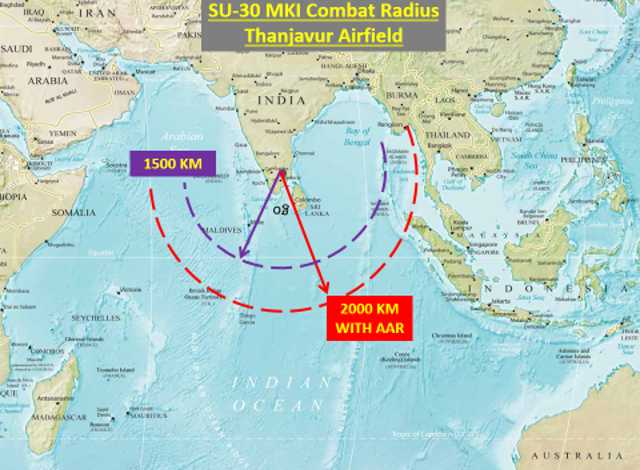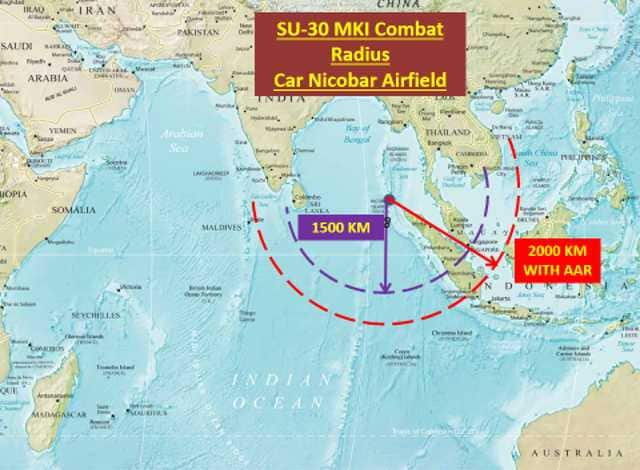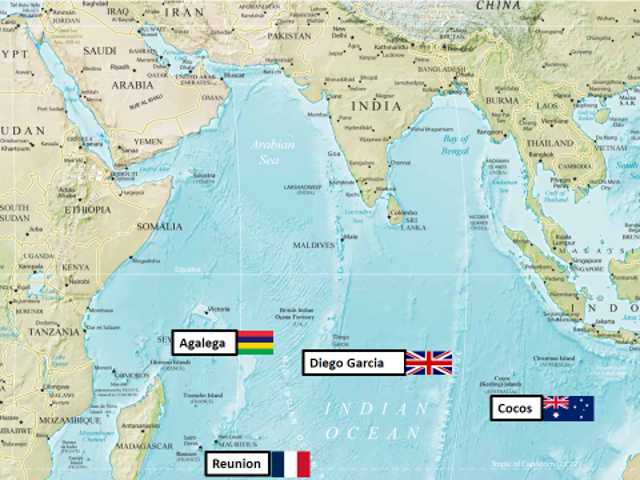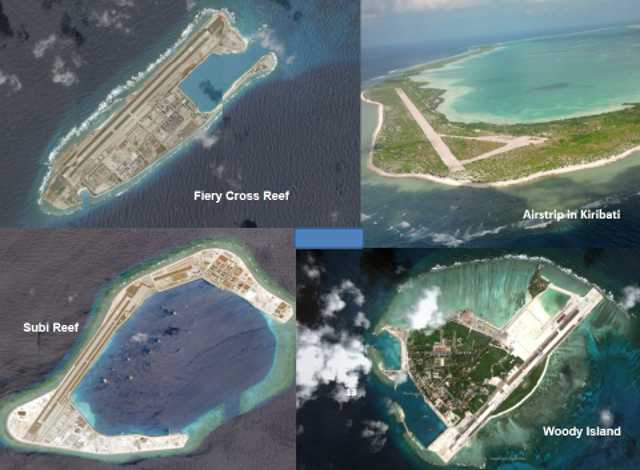Source : Firstpost/IgMp
 |
| INS Vikramaditya (Left) and CNS Liaoning (Right) |
by Air Marshal Anil Chopra
A few days after the PLA Navy marked ten years of its first aircraft carrier Liaoning, a Chinese security officer & military expert said that India should be ready for the PLA carrier battle group that would be sailing in the Indian Ocean very soon.
If China considers India of the lower level of concern, why then does China want to strengthen the Pakistani Navy with submarines and the biggest warship it recently delivered to Islamabad?
The Western Pacific and the Northern Indian Ocean (from the Middle East and East Africa to the Strait of Malacca) have been earmarked by PLAN as the core zones of activity. The sailing of PLAN ships in the Indian Ocean is a brazen provocation.
Chinese ships have been carrying on clandestine surveillance of the Bay of Bengal (BoB). China’s IOR plans are also meant to explore the mineral wealth undersea. China mining the hidden minerals is a direct threat to India’s natural resources.
India preparing for Naval confrontation
The recent commissioning of India’s first Indigenous Aircraft Carrier (IAC-1) into the Indian Navy as INS Vikrant by Prime Minister Narendra Modi was indeed a defining moment. The Indian Navy now has two aircraft carriers and has been pushing for beginning work on the third. As the euphoria began to ebb, analysts started comparing the size of a new carrier, the cost and time taken to build it. The Indian carriers were being compared with the relatively larger Chinese carriers. There were others who wanted the Navy to prioritise the funding between carriers, other ships, and submarines. There were some who wrote about the vulnerability of large ships to cruise and hypersonic missiles, more so after the sinking of the Russian Flagship Cruiser Moskva. Operational return from investment was thus the need of the hour. In view of the competing defence fund requirements, there was a need to take a whole of nation approach.
During a visit aboard the USS George HW Bush, a Nimitz-class supercarrier, that was docked outside of Haifa in July 2017, the Israeli Prime Minister Benjamin Netanyahu pointed towards the shore and said, “There you can see another super-carrier (unsinkable) — the State of Israel.”
Indian Aircraft Carriers
The first INS Vikrant was commissioned in 1961 and had a displacement of 16,000 tonnes. INS Vikramaditya, the refurbished Russian carrier that entered service in 2013, had a 45,400 tonne displacement. The now commissioned, first indigenous aircraft-carrier INS Vikrant was constructed by the Cochin Shipyard Limited (CSL), Kerala. This 262-metre long ship displaces about 45,000 tons, and will have a top speed of 28 knots, and range of 7,500 nautical miles (13,900 km). The Vikrant will house up to 26 MiG-29K fighters, along with 4 Kamov Ka-31 airborne early warning and control helicopters. Alternatively, it could have combinations of HAL Dhruv utility helicopters and MH-60R multi-role helicopters.
The timelines for construction of IAC-1 were stretched. The design began in 1999, the order was placed in 2004, the keel was laid in 2009, and the carrier was floated out of dry dock in December 2011, and launched in August 2013. The basin trials were completed in December 2020, and sea trials began in August 2021. The commissioning ceremony was held on 2 September 2022. Aircraft flight trials will be completed in 2023. The total cost of the project has reportedly been approximately Rs 230 billion ($2.9 billion) till now, and counting. This excludes the cost of on-board aircraft. Typically, the expected life of the carrier could be 40 years.

INS Vikrant can hold 30 fighter planes and helicopters. Twitter/@PiyushGoyal
The proposed 65,000 ton indigenous INS Vishal (IAC-2), is meant to have Electromagnetic Aircraft Launch System (EMALS) CATOBAR system to allow heavier aircraft. The aircraft is meant to replace the Vikramaditya. Analysts say that the Vishal could cost, at current prices, in the order of $16–18 billion (Rs 143,300 crore) including aircraft. In view of the finite naval budget, there continues to be the debate about prioritising between carriers, other ships, and submarines (both nuclear-powered and conventional).

India’s threat perception
Currently, the major threat to India remains on its land borders with our northern and western neighbours where India has to defend territory. The forces are literally sitting eyeball-to-eyeball at a heightened state of alert. There is no immediate such threat from the sea. China’s presence in the Indian Ocean Region (IOR) is increasing slowly. They have a naval base at Djibouti and leased ports at Gwadar (Pakistan) and Hambantota (Sri Lanka). But their presence in IOR will not be very significant for the next two decades. The Chinese PLA Navy’s (PLAN) main requirement in the region is to protect China’s economic interests and sea-lanes. PLAN is powerful by size and numbers but lacks operational experiences and joint operational warfare. Therefore, India’s significant defence funding would have to go towards building land and air power capability to face a territorial conflict, and also to build infrastructure on the two borders.
Dominating the Indian Ocean
Undoubtedly some of the most important sea routes traverse through IOR. India needs to have its own anti-access, area denial capability (A2/AD) in the IOR and prevent hostile powers from getting operational manoeuvrability. Most of the action in IOR is limited to the northern Indian Ocean. India is not looking at expeditionary capability because of limited defence funding and current geostrategic priorities. Aircraft carriers are assets more for Sea control, rather than Sea denial. Today, neither the US nor China can dominate/command seas due to the induction of A2/AD systems like cruise missiles, underwater unmanned autonomous vehicles (UUAV), and Unmanned Aerial Combat Vehicles (UCAV).
Meanwhile China is focusing on enlarging its already significant submarine fleet. The Quad navies are regularly exercising and operating in the Indo-Pacific region. The carriers, though powerful, are costly to acquire and maintain. They also require a large number of ships and submarines to protect the flotilla. By the time India decides to become an expeditionary power and wants to start dominating far seas, the aircraft carriers would become important.
India needs to assess if the northern IOR straddling between the Gulf of Aden and Malacca Strait can be denied by supplementing the Indian Navy’s limited carrier-based air power with much more potent land-based air power. Also the navy could then invest much more in submarines and other surface vessels.
Land-Based air power

Radii of Action Su-30 MKI ex Tanjavur
The Indian Air Force (IAF) has a large number of air bases in the peninsular region. There are also many international airports, and major naval airbases. IAF has significant military air action at Trivandrum, Sulur and Thanjavur. The operational radii of action of the Su-30 MKI is 1,500 kilometres, which increases to over 2,000 kilometres with one aerial refuelling. The radii of Tanjavur airbase is shown in the image above. This would increase further if the aircraft would land back at A&N Island airbases. The coverage from Car Nicobar Islands (in the image below) extends into significant parts of South China Sea. Distance from Jamnagar or Pune, to the Gulf of Oman is 1,100 km and Gulf of Aden 2,100 km. Operating from Pune or Jamnagar airbase, IAF can cover significant distance westward. It can be seen that the aircraft can cover from the Gulf of Aden to well past Malacca Strait and significant parts of northern Indian Ocean.

Radii of Action Su-30 MKI ex Car Nicobar
Andaman and Nicobar Islands airstrips
The Andaman and Nicobar Islands cover 8,249 sq km territory consisting of 572 islands, of which 37 are inhabited. The islands host the Andaman and Nicobar Command, the only tri-service geographical command of the Indian Armed Forces. The territory is just 100 kilometres from Coco Islands of Myanmar, 150 km north of Aceh in Indonesia and separated from Thailand by less than 500 kilometres. Between the Andaman Islands and the Nicobar Islands groups pass the 150 km wide Ten Degree Channel (on the 10°N parallel). Physical distance between the groups is 179 km).
The Veer Savarkar International Airport at Port Blair is a day and night dual use airfield with a single runway of 3,290 m (10,794 ft) in length. Car Nicobar, 278 km south from Port Blair, has an IAF base with a 2,717 m (8,914 ft) runway. The airport elevation is just 5 feet (2 m) above mean sea level. Indian naval air station Baaz is located near Campbell Bay, on Great Nicobar Island. It is 556 km south of Port Blair, and is the southernmost air station of the Indian armed forces, and overlooks the Strait of Malacca as well as the Six Degree channel between Great Nicobar and the Indonesian island of Sumatra. The initial runway was 1,100 m (3,500 ft). It seems to have been extended recently by 900 feet to around 4,400 feet. Later there are plans to extend the runway to 6,000 feet and even 10,000 feet. Once beyond 6,000 then aircraft like Indian Navy’s P8i Poseidon and IAF’s C-130 aircraft will also be able to operate.
At 10,000 feet it will be able to operate all fully loaded fighter class aircraft. Indian fighters, if deployed at the base, can reach the Malacca Strait in minutes. The runways at Car Nicobar and Campbell Bay have very low elevations and have had issues during high tide. They both were badly affected during the Indian Ocean tsunami of 2004. For full-fledged military operations, the airbases would require upgrades for security, technical and logistics infrastructure and hardened shelters.
Shibpur is an Indian naval air station located on North Andaman Island. Established in 2001 as a Forward Operating Air Base (FOAB) for enhanced surveillance in North Andaman, it presently operates Dornier Do 228 aircraft and HAL Chetak helicopters. In 2009, a full-fledged air station was sanctioned. The length of the runway will eventually be extended to 12,000 ft with day and night operations.
Lakshadweep Islands
The 36-island Lakshadweep archipelago is located around 200 to 470 km off India’s Malabar Coast. Only ten islands are inhabited. There is an airport on the 7.6 km long Agatti Island. The island is 459 km west of Kochi on India’s mainland, and has regular civil flights with smaller turboprop aircraft. The 4,235 feet (1,291m) airstrip at Agatti became operational in 1988. There was a plan to extend the runway by constructing a 1,500-feet-long bridge on stilts over the sea, and would have allowed operations of aircraft like the Airbus A320 or Boeing 737.
However, this plan was rejected on environmental grounds. The current plan is to extend the runway by 336 metres towards Kalpati Island without interconnecting the two islands. The only way to make a long runway is to go north by relocating some of the residents. This would have to be a political decision. In the meantime, considering the range of shore-based aircraft, there is no urgency to build a larger airbase at Agatti.

Island airfields of friendly foreign countries
Airstrips in friendly island territories
India has a large number of friendly foreign countries with whom IAF regularly carries out air exercises and has military logistic enabling agreements. These include Coco Keeling Island of Australia, Diego Gracia of UK, and Réunion Islands of France. Some of these could be available in case of significant conflict with China. There is a Memorandum of Understanding between the Government of Mauritius and the Government of India to develop the Agaléga islands and allow India to set up a military base with full runway at North Agalega that can be used for transit and specific operations. Though they are conflicting reports on the actual ground position. India also has radar outposts and other surveillance means at Seychelles, Madagascar and Mauritius.

Chinese Airstrips on Reclaimed Islands in SCS
Defence of island and peninsular airfields
There are at times concerns aired about island runways being denied because they are within the range of the Chinese CJ-10 GLCMs and DF-21 IRBMs deployed by the PLA. The same logic can apply to all the runways built by China on the reclaimed Islands in South China Sea (SCS) (image above). India’s mainland airfields will be defended as per air defence of India operational plans. Andaman and Nicobar Islands are large territories and will be suitably defended with air defence assets, that are no less than an aircraft carrier. Once India decides to invest more in the strategic island territories, powerful long-range radars, and Surface-to-Air Missiles (SAM) will be positioned. Air defence fighters will be permanently placed.
The way ahead
India is geographically blessed to be sitting in the shape of a dagger in the Indian Ocean. The Andaman and Nicobar Islands are the most strategically located islands anywhere in the world. For long, India had not exploited their strategic potential for ecological and social reasons. However, the formation of Andaman and Nicobar Command (ANC) in 2001 was a signal of their importance and India’s intent. India must build initially two and later another major airfield complex at A&N Islands with full airbase infrastructure. To begin with one IAF fighter squadron must be permanently based there. A few naval P8I could also be positioned for short periods on a regular basis. Adequate air defence radars and missile systems be placed at the disposal of ANC.
India must invest in larger numbers of air and ground launched cruise missiles. There is also a need to accelerate hypersonic missile technology. Autonomous submarines would be great assets for sea denial. China is already pulling ahead. Infrastructure and asset investments take time. The time to act is now.
The writer is Director General, Centre for Air Power Studies. Views expressed are personal.






.jpeg)


0 Comments